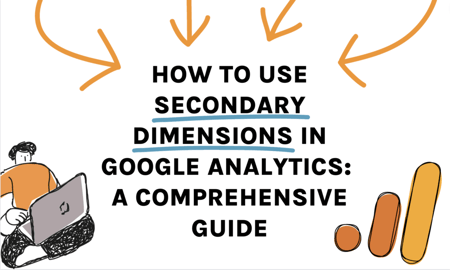From Data to Method: How Secondary Dimensions Raise Your Search Engine Optimization Efforts
From Data to Method: How Secondary Dimensions Raise Your Search Engine Optimization Efforts
Blog Article
Maximize Your Coverage Precision With Second Dimensions
In the world of information evaluation, the pursuit for precision and deepness is a continuous quest. Additional dimensions use a portal to augmenting reporting precision by supplying a multifaceted lens with which to watch data. Envision the power of unraveling intricate layers of details that exist beyond the surface area metrics, offering a richer tapestry of understandings waiting to be explored. As we get started on this journey of leveraging secondary measurements, the landscape of reporting precision bids with promises of improved quality and strategic decision-making.
Significance of Second Measurements
Using additional measurements is essential for enhancing the depth and granularity of reporting understandings in data analysis. Additional dimensions allow experts to section and filter information based on particular standards, offering a much more customized and targeted evaluation.
In addition, additional measurements aid in determining relationships and partnerships that may not be quickly apparent when evaluating data with just key dimensions. This deeper level of understanding can lead to even more informed decision-making and critical preparation within a company. By leveraging additional dimensions effectively, businesses can discover concealed possibilities, pinpoint locations for enhancement, and enhance their total efficiency.
Applying Additional Dimensions
To include additional dimensions successfully right into information analysis procedures, organizations should take on a structured method that lines up with their reporting objectives and logical goals. Implementing secondary dimensions involves selecting the right measurements that offer much deeper understandings right into key information metrics. It is crucial to recognize which second measurements will certainly improve the understanding of the main data being examined. Businesses ought to take into consideration elements such as the kind of data being gathered, the certain metrics they intend to assess, and the crucial performance indications (KPIs) they are concentrated on improving.
In addition, organizations require to ensure that the selected second dimensions pertain to the key data and give purposeful context without causing info overload. Executing second measurements likewise requires specifying clear logical concerns that the extra dimensions will aid address. By structuring the application procedure around these factors to consider, services can make the most of the worth derived from additional measurements and improve the accuracy and deepness of their coverage.
Studying Data With Additional Dimensions

One key facet of examining data with second dimensions is to make sure that the chosen dimensions straighten with your certain analytical objectives. Picking the right second measurements can supply context and nuance to your primary data metrics, enabling you to draw more accurate conclusions and make informed choices based on the understandings got.
Additionally, leveraging additional measurements effectively can aid in recognizing outliers, comprehending the influence of various variables on your key performance indications, and gaining an extensive view of your data landscape. By delving right into information with secondary measurements, you can improve the deepness and top quality of your analysis, causing even more durable reporting and workable results.

Enhancing Insights Via Additional Dimensions
Exploring data through second measurements not only grows analysis but also enhances the potential for revealing useful understandings that can dramatically boost reporting accuracy. By including second measurements to your records, you try this site can gain a much more extensive understanding of the relationships in between various data factors. This boosted perspective enables you to identify patterns, fads, and relationships that may have been neglected when assessing information with key dimensions alone.

In significance, leveraging secondary dimensions equips you to remove richer insights from your information, enabling you to make even more educated decisions and maximize your coverage precision.
Best Practices for Additional Measurements
Utilizing reference additional measurements successfully calls for careful factor to consider of crucial methods to boost information evaluation and reporting precision. When carrying out additional measurements, it is important to straighten them with your primary metrics to acquire purposeful understandings.
One more essential method is to experiment with different mixes of key and additional measurements to uncover special correlations and patterns within your data. This iterative method can disclose useful insights that might have been overlooked otherwise. In addition, it is necessary to regularly review and fine-tune your secondary dimension selections to ensure they stay pertinent and lined up with your evolving reporting demands.
Furthermore, documenting the reasoning behind your selection of additional dimensions can offer context for future analysis and facilitate partnership within your team. By following these best methods, you can maximize the efficiency of additional dimensions in improving your reporting accuracy and driving informed decision-making.
Final Thought
Incorporating second measurements in information evaluation is crucial for taking full advantage of reporting precision and gaining much deeper insights right into performance fads. By purposefully selecting extra information factors, analysts can reveal covert relationships and make educated choices. secondary dimensions. Applying ideal techniques for additional dimensions enhances the depth of evaluation and enhances the significance of reporting outcomes. This strategy eventually results in extra exact and nuanced analyses of information, resulting in more educated decision-making.
Additionally, second dimensions help in identifying correlations and partnerships that might not be instantly apparent when examining information with just main dimensions. Executing secondary measurements includes picking the appropriate measurements that offer much look at more info deeper insights into main data metrics. Executing secondary dimensions additionally requires defining clear logical questions that the extra measurements will certainly assist answer.When evaluating data with secondary dimensions, it is essential to focus on drawing out beneficial understandings that complement key data metrics. By integrating additional dimensions right into your evaluation, you can discover patterns, trends, and partnerships that may not be noticeable when looking at the information from a primary dimension alone.
Report this page